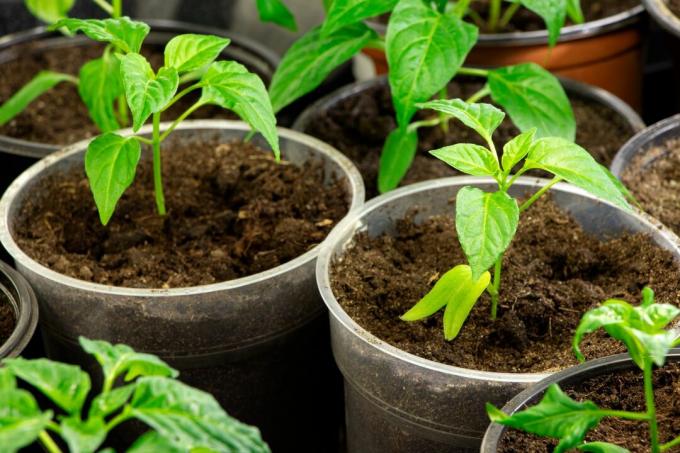Growing bell peppers in your own garden: We present suitable varieties and give tips and tricks on everything from sowing to care and fertilization to harvesting.

the paprika (Capsicum) is a member of the nightshade family (Solanaceae), like the tomato and also the eggplant. The origin of the peppers is in Central and South America. There was already 7000 BC. Chr. active cultivation. After discovering South America, Christopher Columbus brought the seeds to Spain and called them Pimienta, which means pepper in Spanish. Since then, this name has been common in Spain and numerous types of pepper are grown on the Iberian Peninsula to this day. However, cultivation in German gardens is also possible. Tomato or greenhouses are best, but cultivation outdoors, on the balcony or terrace is also possible without any problems.
Choose the right kind of pepper
There are different options to choose from Paprika varieties, a few popular ones here briefly summarized:
- De Capriglio: Variety from northern Italy; with round and red fruits.
- Yellow tomato peppers: Variety from Hungary; flat, ribbed fruits; yellow to orange color.
- Gypsy: good variety for the greenhouse.
- Lemon drop: yellow pointed pepper with a subtle citrus note; a bit spicy.
- Neusiedler ideal: medium-ripe variety with very large paprika fruits; red ripening.
- Red Augsburg: suitable for outdoor cultivation; very sweet, red fruits.
- Sweet chocolate: large, purple fruits.
Growing peppers - this is how it works step by step
We will take you through the gardening year with brief instructions - from seeds to fresh peppers.
- You should start germinating towards the end of February through the first week of March. Our recommendation is a small greenhouse or installation on a suitable window sill.
- It is best to use spring pots made of peat and plant your cuttings including peat Sheathing in suitable larger pots as soon as the young plants reach a height of about 10 to 15 cm achieved. Always make sure you have enough sunlight and warmth!
- When the ice saints are over, it is best to go straight to the planting in the field, in the greenhouse, on the balcony or on your terrace. Get used to the little pepper plants in the new environment, the direct sun and the unfamiliar temperatures. To do this, always place the pots in the desired location a little longer for a few days, after which you can start planting.
- The space for the pepper plants should provide plenty of sun and good soil conditions. Improve each planting hole with plenty of compost, horn shavings and, if necessary, also with about crap. It is best to also loosen up the surrounding soil!

- Thorough preparation for the planter is important; our recommendation here is to prepare a hole about 40 to 50 cm deep.
- Insert the cuttings as deeply as possible, leaving a gap of approx. 40 x 40 cm.
- It is important to keep an eye on the growth. As soon as the pepper plants have reached a height of between 20 and 30 cm, you have to break out the main shoot. In the case of large-growing varieties, the first blossom of the paprika (royal blossom) must be broken out. As a result, the pepper plant grows in width!
- Over the summer you can add additional nutrients with a mainly organic organic fertilizer. Make sure, however, that it does not contain nitrogen! As a result, the plants would grow too lush, but hardly produce any flowers. Our potassium-accentuated Plantura is very suitable Organic tomato fertilizer with long-term effect.
- Depending on the variety, the harvest is from August to October. After a mixed summer, not all pods may be able to ripen. You can simply remove green peppers and let them ripen on a windowsill.
Important tip: Label your varieties with their respective names in order to be able to determine the perfect color at harvest time and thus the best time to collect the fresh pods.

